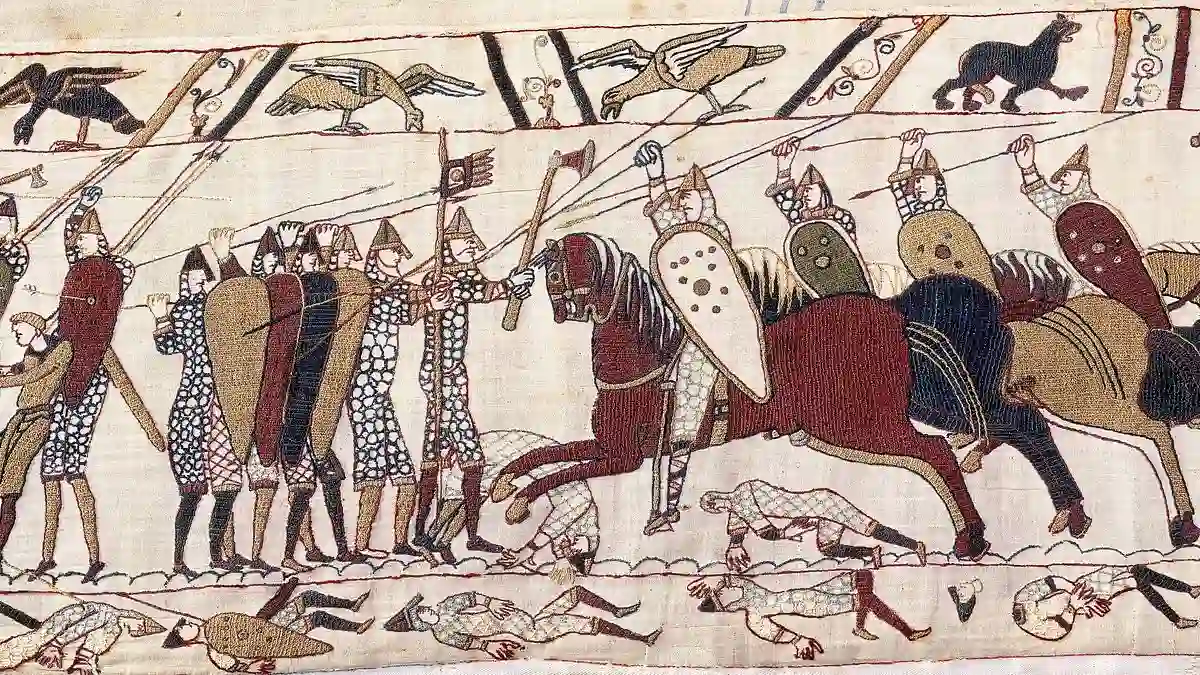We’ve all grown up calling it the Bayeux Tapestry, but what if we’ve been getting it wrong all along?
According to a leading historian, the famous 11th-century cloth that tells the story of the Norman Conquest was probably made in Canterbury, England — and it’s not even technically a tapestry.
As the 230-foot-long piece of history prepares to go on display at the British Museum next year, experts are seizing the moment to challenge everything we thought we knew about its origins.
It’s Not a Tapestry — It’s an Embroidery
Let’s start with the basics. Dr David Musgrove, a historian and host of the BBC’s History Extra podcast, explains that the Bayeux Tapestry isn’t actually a tapestry at all — it’s an embroidery.
Tapestries are woven into fabric; this piece was made by stitching dyed wool threads onto linen.
That alone, he says, makes the term “tapestry” misleading. But it doesn’t stop there.
Musgrove argues the piece should be called the Canterbury Embroidery, because all signs point to it being crafted in Kent, not France.
The name might not be as catchy, he admits, but it could be a more accurate reflection of its true heritage.
Made in England? Here’s the Evidence
The embroidery famously illustrates the events leading up to the 1066 Battle of Hastings, where William the Conqueror defeated King Harold II.
While it’s long been associated with Bayeux Cathedral in Normandy, historians now believe the cloth was created much closer to home.
Musgrove says the evidence suggests it was likely made in Canterbury by Anglo-Saxon women, working in teams.
You can even see where panels were stitched together slightly out of alignment — a sign they were made separately, perhaps in different workshops.
At the time, Canterbury was known for its skilled seamstresses, and the English had a rich tradition of embroidery, especially within religious communities.
That context strengthens the case for a British origin.
A Rare Opportunity for Discovery
The embroidery’s upcoming stay at the British Museum is more than just a public display — it’s a golden opportunity for scholars.
Dr Musgrove says the trip gives researchers a rare chance to examine the back of the embroidery, which has been hidden for centuries beneath added protective layers.
By studying it closely, they may uncover new clues about how and where it was made.
And that’s not all.
Scientists hope to run non-invasive tests on the fabric — examining the wool, dyes, and flax used — to determine the likely source of the materials.
If they trace back to England, it could finally confirm that the Bayeux “Tapestry” is truly British.
AI Could Help Solve the Mystery
In today’s world, even medieval mysteries can be tackled with artificial intelligence.
Dr Musgrove suggests that computer models could help compare stitching patterns or stylistic features across the panels.
That kind of analysis might reveal patterns or techniques unique to Anglo-Saxon embroidery, offering further proof of the cloth’s English origins.
But of course, everything must be done carefully — after all, we’re talking about an 11th-century treasure.
The Tapestry’s Tumultuous Journey
This isn’t the first time the embroidery has left France.
Its history includes near destruction, political symbolism, and even a Nazi obsession.
Here’s a quick timeline of its travels:
-
1066: The Battle of Hastings takes place.
-
1476: The cloth is first mentioned in an inventory of Bayeux Cathedral.
-
1730s: The first English description is written (but not published for decades).
-
1792: During the French Revolution, it was nearly used as wagon covering before being rescued by a lawyer.
-
1804: Napoleon displayed it in Paris while planning to invade Britain.
-
1870: It was moved again during the Franco-Prussian War.
-
1944: The Gestapo seized it just before retreating from France. Nazi leaders, including Heinrich Himmler, viewed it as part of Germanic history.
-
1945: It returned to Bayeux, where it’s remained until now.
A Royal Boost for the British Museum
French President Emmanuel Macron recently revealed that King Charles played a key role in getting the tapestry temporarily returned to Britain.
Macron even admitted that France wasn’t too keen on loaning it out — but the King helped push the agreement through.
While the embroidery is in London, some of Britain’s greatest historical artefacts — including the Sutton Hoo Anglo-Saxon treasures — will head to France in exchange.
When and Where You Can See It
If you’re eager to see the embroidery up close, mark your calendar.
The Bayeux Tapestry — or should we say Canterbury Embroidery? — will be on display at the British Museum from autumn 2026 to July 2027.
It’s not just a trip through history — it’s a chance to settle one of the biggest heritage debates of the last millennium.
And maybe, just maybe, it’s time we all started calling it by its real name.
